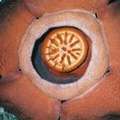 世界上最大的開花植物,是從極小的花朵演化成現在的尺寸。最典型的便是花體超過3呎寬、芽體尺寸如籃球般大的植物,這是本週植物學家在《科學》期刊中發表的最新報告。
世界上最大的開花植物,是從極小的花朵演化成現在的尺寸。最典型的便是花體超過3呎寬、芽體尺寸如籃球般大的植物,這是本週植物學家在《科學》期刊中發表的最新報告。
科學家們對大花草(rafflesia)的基因研究顯示出,大花草屬與大戟屬(poinsettias)、蓖麻、熱帶根系穀物木薯屬植物,以及橡膠樹的關係極為接近。
哈佛大學藝術與科學學院演化生物學助理教授戴維斯說:「大花草的親系關係已困擾了植物學家將近200年之久,它是在一種熱帶藤蔓植物組織中的寄生植物,這種植物沒有葉片、嫩枝或根的部份,也令其難以與較常見的植物做比較。」
「在過去25年,在植物的生命樹上確認植物位置的主要方式,是利用控制光合作用基因中的的分子標記,來找出先祖植物的痕跡。」戴維斯表示,「大花草是一種不行光合作用的寄生植物,這種基因已經幾乎消失了,這表示我們必須從植物基因組中的其他部分,去找出它的親系關係。」
戴維斯及他的研究團隊推測:大花草的花體從4600萬年前,開始以快速的步調演化成現在重達15磅的形狀。然後,在增大尺寸近79倍後,才恢復以較緩慢的演化速度進行。
科學家在研究了1萬1500對DNA後,終於確定與大花草親緣關係最近的植物便是大戟科植物,而這種植物的花體直徑向來只有幾毫米而已。
聖路易市密蘇里植物園園長拉文(Peter Raven)說:「花體尺寸的大幅度增長,是生物中最重要的一個發現,而且不可能以一般習慣的方法推論出此種變化。」
The plant with the world's largest flower - typically a more than three feet across, with a bud the size of a basketball - evolved from a family of plants whose blossoms are nearly all tiny, botanists write this week in the journal "Science."
Their genetic analysis of rafflesia reveals that it is closely related to a family that includes poinsettias, castor oil plants, the tropical root crop cassava, and the trees that produce natural rubber.
"For nearly 200 years rafflesia's lineage has confounded plant scientists," says Davis, an assistant professor of evolutionary biology in Harvard's Faculty of Arts and Sciences. "As a parasite living inside the tissue of a tropical vine, the plant lacks leaves, shoots, or roots, making it difficult to compare to more conventional plants."
"Most efforts to place plants in the botanical tree of life in the past 25 years have tracked ancestry using molecular markers in genes governing photosynthesis," said Davis. "Rafflesia is a non-photosynthetic parasite, and those genes have apparently been abandoned, meaning that to determine its lineage we had to look at other parts of the plant's genome.。"
Davis and his colleagues determined that over about 46 million years, rafflesia's blooms, which now weigh up to 15 pounds, evolved at an accelerated pace. Then, after increasing in size by a factor of roughly 79, the plant reverted to a slower evolutionary pace.
Scientists looked at some 11,500 base pairs of DNA to determine that the giant flower's closest relatives are in the Euphorbiaceae family, many of which have blossoms just a few millimeters in diameter.
"The massive increase in flower size is one of the most significant among living organisms, and could never have been deduced by conventional methods." says botanist Peter Raven, president of the Missouri Botanical Garden in St. Louis.





